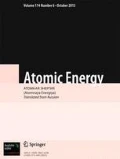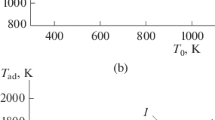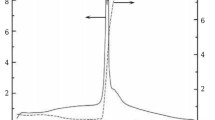Summary
-
1.
Thermodynamic calculations have shown the possibility of the reduction-carbidization of ZrO2 by calcium carbide in the temperature range 900–1200°C. In an atmosphere of nitrogen or with the use of calcium cyanamide the reduction is accompanied by the liberation of an additional amount of free energy with the formation of zirconium carbonitride. The calculations show the possibility of participation in the reduction process not only of calcium but also of some of the carbon contained in the calcium carbide or cyanamide; the free energy which is then liberated is relatively small.
-
2.
Experimental studies of the carbonitriding of ZrO2 by calcium carbide and cyanamide in a stationary atmosphere of nitrogen showed that an approach to saturated zirconium carbonitride is reached in 4h at 1100°C. with increase in temperature in the limits 900–1100°C the rate of the process increases noticeably and the N/Ccomb ratio in the obtained carbonitride increases, especially if calcium cyanamide is used. This would seem to indicate that nitrogen liberated from calcium cyanamide during the reaction is more active than the molecular nitrogen filling the reaction space during the reduction of ZrO2 by calcium carbide.
-
3.
We have shown that during the reduction of ZrO2 by calcium cyanamide the amount of nitrogen in its composition is sufficient for an approach to saturated zirconium carbonitride in an inert gas atmosphere (argon); consequently, the reduction process is possible in an atmosphere of generator gas, decomposed natural gas, or other protective gas.
-
4.
An experimental check of the possibility of some of the carbon of calcium carbide or cyanamide taking part in the reduction process showed that in a stationary atmosphere of nitrogen and a temperature up to 1100°C the consumption of reducing agent cannot be reduced below 100%. When the resulting carbon monoxide is removed from the sphere of reaction by blowing with nitrogen the resulting product is close to the saturated zirconium carbonitride, with consumption of calcium cyanamide 80% of the theoretical amount.
A reduction in the consumption of calcium carbonide below 100% gives less satisfactory results even when a current of nitrogen is used; this is apparently due to the lower stability of calcium carbide (compared with calcium cyanamide) with respect to water vapor and carbon monoxide.
Similar content being viewed by others
Literature Cited
W. Kroll, W. Stephens, and H. Holmes, J. Metals.,188, 12 (1950).
A. Schneider and G. Hutt, Z. anorgan. und allgem. Chem.,257, 289 (1948).
A. S. Mikulinskii and R. N. Rubinshtein, “Legkie metally,” No. 10, 15 (1937).
Pak Men Cho and A. I. Belyaev, “Tr. Mosk. inst. tsvet. met. i zolota im. M. I. Kalinina,” No. 24, 172 (1954).
H. Sawamoto, Mining. Inst. Japan.,71, 800 (1955).
Japanese Patent No. 9656, 1958.
G. A. Meerson, L. M. Yakesheva, and T. A. Shvedova, “Izv. AN SSSR, Otd. tekhn. n. Metallurgiya i toplivo,” No. 1, 69 (1963).
R. Domogala and M. McPherson, Trans. Amer. Inst. Mining and Met. Engrs.,200, 238 (1954).
O. Kubaschewski and E. Evans, Metallurgical thermochemistry, Pergamon Press, London, 1958.
W. Pearson, A Handbook of Lattice Spacings and Structures of Metal and Alloys, Pergamon Press, London, 1958.
Additional information
Translated from Atomnaya Énergiya, Vol. 14, No. 6, pp. 563–568, June, 1963
Rights and permissions
About this article
Cite this article
Meerson, G.A., Olesov, Y.G. & Pryalochnikov, V.I. The reduction of zirconium dioxide by calcium carbide and cyanamide. At Energy 14, 586–592 (1964). https://doi.org/10.1007/BF01119974
Received:
Issue Date:
DOI: https://doi.org/10.1007/BF01119974




